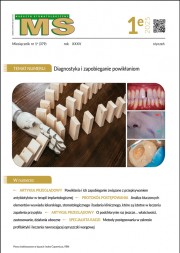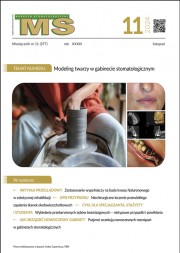Dostęp do tego artykułu jest płatny.
Zapraszamy do zakupu!
Cena: 12.50 PLN (z VAT)
Kup artykuł
Po dokonaniu zakupu artykuł w postaci pliku PDF prześlemy bezpośrednio pod twój adres e-mail.
MS 2021; 7-8: 10-16.
Zapalenie stawów skroniowo‑żuchwowych w przebiegu boreliozy – aspekt stomatologiczny
Temporomandibular arthritis in the course of Lyme disease‑dental aspect
Joanna Mucha, Marta Kodzik, Piotr Kopaczewski
Streszczenie
Borelioza jako zapalna choroba układowa ma wpływ na skórę, serce, układ nerwowy i stawy, w tym na stawy skroniowo‑żuchwowe. Ból, ograniczone odwiedzenie żuchwy i objawy akustyczne w stawie skroniowo‑żuchwowym podczas ruchów są jednymi z wczesnych objawów boreliozy, które mogą mylnie wskazywać na zaburzenia czynnościowe układu ruchowego narządu żucia. Rozpoznanie boreliozy musi się opierać na dobrze przeprowadzonym wywiadzie, badaniu klinicznym i diagnostyce laboratoryjnej, a leczenie na prawidłowej antybiotykoterapii. Dlatego tak ważna jest diagnostyka różnicowa i wiedza lekarza dentysty na temat boreliozy i jej implikacji stomatologicznych.
Abstract
Lyme disease is an inflammatory systemic disease can affect the skin, heart, nervous system and joints, including the temporomandibular joints. Pain, limited mouth opening and sounds in the joints during movements are some of the early symptoms that may mistakenly indicate a functional disorder of the masticatory system. The diagnosis of Lyme disease must be based on a well‑conducted history, clinical examination and laboratory tests. The treatment includes appropriate antibiotic therapy. This is the reason why differential diagnosis, the dentist’s knowledge of Lyme disease and its dental implications are so significant.
Hasła indeksowe: borelioza, boreliozowe zapalenie stawów, staw skroniowo‑żuchwowy
Key words: borreliosis, Lyme arthritis, temporomandibular joint
PIŚMIENNICTWO
- Steere AC, Coburn J, Glickstein L. The emergence of Lyme disease. J Clin Invest. 2004; 113(8): 1093-1101.
- Sigal LH. Lyme disease: a clinical update. Hosp Pract. (Minneap). 2001; 7: 31-47.
- Grzeszczuk A. Borelioza w praktyce klinicznej. Warszawa: Wydawnictwo Lekarskie PZWL; 2009.
- Stańczak J, Kubica-Biernat B, Racewicz M i wsp. Detection of three genospecies of Borrelia burgdorferi sensu lato in Ixodes ricinus ticks collected in different regions of Poland. Int J Med Microbiol. 2000; 290: 559-566.
- Błaut-Jurkowska J, Jurkowski M. Borelioza – aktualny stan wiedzy. Przegl Lek. 2015; 72(11): 256-260.
- Krzyczmanik D, Sińczuk-Walczak H, Wittczak T i wsp. Borelioza w praktyce Lekarza Medycyny Pracy. Med Pr. 2012; 63(4): 483-492.
- Dattwyler RJ, Volkamn DJ, Luft BJ i wsp. Seronegative Lyme disease. Dissociation of specific T- and B lymphocyte responses to Borrelia burgdorferi. N Engl J Med. 1988; 319(22):1441-1446.
- Smoleńska Ż, Matyjasek A, Zdrojewski Z. Borelioza – najnowsze rekomendacje w diagnostyce i leczeniu. Forum Reumatologiczne. 2016; 2(2): 58-64.
- Steere AC. Lyme disease. N Engl J Med. 2001; 345(2): 115-125.
- Flisiak R. Borelioza z Lyme. W: Cianciara J, Juszczyk J (red.). Choroby zakaźne i pasożytnicze. Lublin: Wydawnictwo Czelej; 2007, s. 473-485.
- Yale SH, Allison BD, Hauptfuehrer JD. An epidemiological assessment of mandibular condyle morphology. Oral Surg Oral Med Oral Pathol. 1966; 21(2): 169-177.
- Bochenek A. Anatomia człowieka. Warszawa: PZWL; 1978.
- Brooks SC, Westesson PL, Eriksson L. Prevalence of osseous changes in the temporomandibular joint of asymptomatic persons without internal derangement. Oral Surg Oral Med Oral Pathol. 1992; 73(1): 118-122.
- Kostrzewa-Janicka J, Anulewicz A, Mierzwińska-Nastalska E. Aspekty budowy makroskopowej i mikroskopowej stawów skroniowo-żuchwowych na podstawie piśmiennictwa. Protet 2007; 57(2): 97-104.
- Minarelli AM, Liberti EA. A Microscopic survey of human temporomandibular joint disc. J Oral Rehab. 1997; 24(11): 835-884.
- Scapino RP. The posterior attachment: Its structure, function and appearance in TMJ imaging studies. Part 1. J Craniomandib Discord. 1991; 5(2): 83-95.
- Harris RJ. Lyme disease involving the temporomandibular joint. J Oral Maxillofac Surg. 1988; 46(1): 78-79.
- Heir GM, Fein LA. Lyme disease: considerations for dentistry. J Orofacial Pain. 1996; 10(1): 74-86.
- Nowakowski G, Kochańska-Dziurowicz A, Widala E. Tick spirochetosis - Lyme borreliosis. Przegl 2000; 57(7-8): 424-426.
- Flisiak R, Pancewicz S. Diagnostics and treatment of Lyme borreliosis. Recommendations of Polish Society of Epidemiology and Infectious Diseases. Przegl Epidemiol. 2008; 62(1): 193-199.
- Prokopowicz D, Flisiak R. Clinical picture of Lyme borreliosis. Wiad 1999; 45: 143-149.
- Prokopowicz D. Borelioza z Lyme – profilaktyka i leczenie. Lekarz. 2002; 1: 22.
- Hermanowska-Szpakowicz T, Zajkowska JM, Pancewicz SA i wsp. Pathogenetic-clinical problems of Lyme borreliosis. Neurol Neurochir Pol. 2003; 37(Suppl 2): 29-38.
- Szechiński J, Wiland P. Reumatologia. Zmiany narządowe. Wrocław: Wydawnictwo Medyczne Górnicki; 2001.
- Lader E. Lyme disease misdiagnosed as a tempomandibular joint disorder. J Prosthet Dent. 1990; 60(1): 82-85.
- Przytuła L, Gińdzieńska-Sieśkiewicz E, Sierakowski S. Diagnosis and treatment of Lyme arthritis. Przegl Epidemiol. 2006; 60(1): 125-130.
- Steere AC. Diagnosis and treatment of Lyme arthritis. Med Clin North Am. 1997; 81(1): 179-194.
- Stanek G, Strle F. Lyme borreliosis. Lancet. 2003; 362(9396): 1639-1647.
- Steere AC, Duray PH, Butcher EC. Spirochetal antigens and lymphoid cell surface markers in Lyme synovitis. Comparison with rheumatoid synovium and tonsillar lymphoid tissue. Arthritis Rheum. 1988; 31(4): 487-495.
- Rees DH, Axford JS. Lyme arthritis. Ann Rheum Dis. 1994; 53(9): 553-556.
- Franz JK, Krause A. Lyme disease (Lyme borreliosis). Best Practice & Research Clin Rheumatol. 2003; 17(4): 241-264.
- Flisiak R, Szechiński J. Choroby przenoszone przez kleszcze. W: Gajewski P (red.). Interna Szczeklika. Podręcznik Chorób Wewnętrznych. Kraków: Medycyna Praktyczna; 2014, s. 2289-2298.














